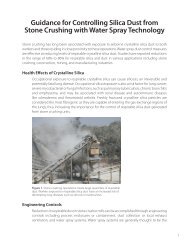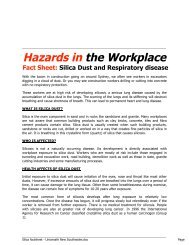Safety & Health in the Stone Crushing Industry - Occupational ...
Safety & Health in the Stone Crushing Industry - Occupational ...
Safety & Health in the Stone Crushing Industry - Occupational ...
Create successful ePaper yourself
Turn your PDF publications into a flip-book with our unique Google optimized e-Paper software.
12<br />
Picture 2: women collect<strong>in</strong>g dust under <strong>the</strong> conveyer belts<br />
The "Hierarchy of Controls"<br />
When th<strong>in</strong>k<strong>in</strong>g about solutions, consider <strong>the</strong> pr<strong>in</strong>ciples below, if possible <strong>in</strong> order, <strong>the</strong> so-called<br />
hierarchy of controls:<br />
1. try a less risky option (e.g. switch to us<strong>in</strong>g a less hazardous chemical);<br />
2. prevent access to <strong>the</strong> hazard (e.g. by guards around mach<strong>in</strong>ery or rails);<br />
3. organize work better to reduce exposure to <strong>the</strong> hazard (e.g. don't allow on-lookers dur<strong>in</strong>g<br />
unload<strong>in</strong>g or stop runn<strong>in</strong>g <strong>the</strong> crusher while clean<strong>in</strong>g up to reduce dust exposure);<br />
4. provide personal protective equipment (e.g. cloth<strong>in</strong>g, footwear, goggles etc); and provide<br />
welfare facilities (e.g. first aid and wash<strong>in</strong>g facilities for removal of contam<strong>in</strong>ation).<br />
Improv<strong>in</strong>g health and safety often does not cost a lot. For <strong>in</strong>stance, plac<strong>in</strong>g a mirror on a dangerous<br />
bl<strong>in</strong>d corner to help prevent vehicle accidents is a low-cost precaution consider<strong>in</strong>g <strong>the</strong> risks. Failure to<br />
take simple precautions can cost you a lot more if an accident does happen (you will f<strong>in</strong>d a cost<br />
calculation <strong>in</strong> chapter How much does an Accident Cost?). We can only encourage you to <strong>in</strong>volve your<br />
workers <strong>in</strong> this discussion, so that you can be sure that what you propose will work <strong>in</strong> practice and will<br />
not <strong>in</strong>troduce new hazards.<br />
Step 4 Record your f<strong>in</strong>d<strong>in</strong>gs and implement <strong>the</strong>m<br />
Putt<strong>in</strong>g <strong>the</strong> results of your risk assessment <strong>in</strong>to practice will make a difference when look<strong>in</strong>g after<br />
people and your bus<strong>in</strong>ess. Writ<strong>in</strong>g down <strong>the</strong> results of your risk assessment, and shar<strong>in</strong>g <strong>the</strong>m with<br />
your staff, encourages you and <strong>the</strong>m to follow your solutions correctly, for <strong>in</strong>stance your new work<br />
practices and work orders. If you have only few employees, you do not have to write anyth<strong>in</strong>g down.<br />
However, notes are useful so that you can review <strong>the</strong>m later when someth<strong>in</strong>g changes.







